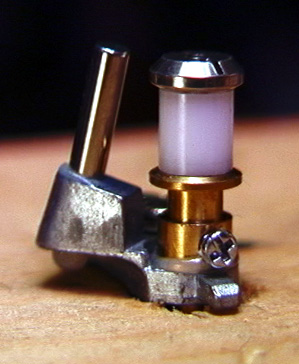CLIMBING THE ALPS
Tascam's TC DAT decks are more affordable than Sony's hence the former
find their way into many audio facilities while the latter are more common
in video houses. All of Tascam's DAT transports are made by Alps,
an Original Equipment Manufacturer (OEM) responsible for the mechanisms
found in the Otari DTR-90, the Fostex PD-2 (portable) and D-30 (rack mounted)
TC DAT recorders. By some stroke of luck, or genius, Fostex ditched
the problematic front-loading "elevator," opting instead for a simple,
trouble-free hinged loading door. (Sony, Panasonic and Pioneer make
their own DAT transports. The Fostex D-5 and Tascam DA-20 are entirely
made by Pioneer. The transport in those machines found its way into
the Fostex D-15 and PD-4 as well.)
CHICKEN, EGG or just the CLAW?
The ALPS loading mechanism is a little too delicate for impatient Americans
who are accustomed to slamming VHS tapes into their home VCRs. Cassettes
not gently inserted will easily bend metal parts, pushing electro-mechanical
tolerances beyond the machine's ability to compensate. Four common
symptoms plague the ALPS front-loading mechanism. It can either be
sluggish or too hungry during feeding, the latter being least desirable.
On a good day, a cassette sucked in before being securely engaged will
be ejected. (On a bad day, the machine will jam.) During the unload
process, the "Central Scrutinizer" may not sense that the tape is fully
ejected, causing an endless "déjà vu" of load and unload.
To spare you some mental anguish for the moment, the fourth symptom is
described under the heading, "The Claw."
SPRING INTO ACTION
Three sensing switches are hidden on the underside of the right "junction"
PCB as shown in Figure-2A. (The visible side of this PCB is
shown in Figure-2B.) No adjustments are provided and initial
attempts at creating an adjustment "window" yielded mixed results.
Since mechanical friction seems inconsistent amongst the various mechanisms,
a more basic fix, shown in Figure Three, involves adding a spring that
serves
a double purpose. As the cassette is loaded, the spring creates resistance
so that the tape is fully engaged before tripping the sensor switch.
On the return trip, the spring ensures that the mechanism returns to the
same "at rest" position, positively disengaging the switch.
DIY
I searched high and low for the perfect spring, finally settling on
the type used by Tascam for the loading drawer of the DA-30 and DA-30 MKII
(part number 5801396801). Cut the spring in half, fold out the last
coil so that it can be easily hooked and attach as shown in Figure Three,
below.

